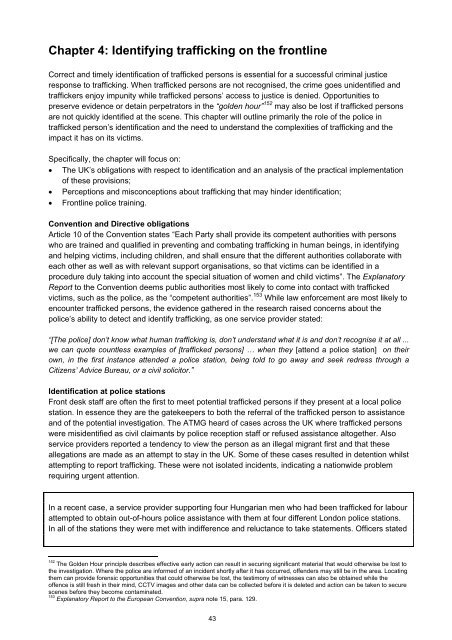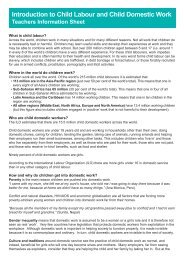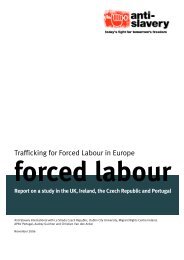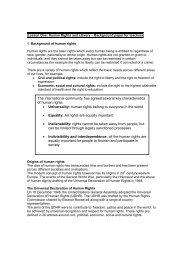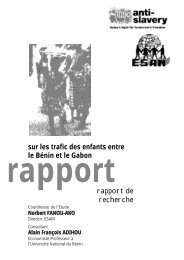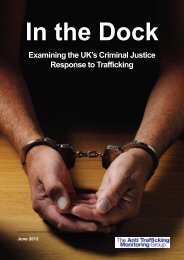In the Dock
Full report (1810.59KB) - Anti-Slavery International
Full report (1810.59KB) - Anti-Slavery International
Create successful ePaper yourself
Turn your PDF publications into a flip-book with our unique Google optimized e-Paper software.
Chapter 4: Identifying trafficking on <strong>the</strong> frontlineCorrect and timely identification of trafficked persons is essential for a successful criminal justiceresponse to trafficking. When trafficked persons are not recognised, <strong>the</strong> crime goes unidentified andtraffickers enjoy impunity while trafficked persons’ access to justice is denied. Opportunities topreserve evidence or detain perpetrators in <strong>the</strong> “golden hour” 152 may also be lost if trafficked personsare not quickly identified at <strong>the</strong> scene. This chapter will outline primarily <strong>the</strong> role of <strong>the</strong> police intrafficked person’s identification and <strong>the</strong> need to understand <strong>the</strong> complexities of trafficking and <strong>the</strong>impact it has on its victims.Specifically, <strong>the</strong> chapter will focus on:• The UK’s obligations with respect to identification and an analysis of <strong>the</strong> practical implementationof <strong>the</strong>se provisions;• Perceptions and misconceptions about trafficking that may hinder identification;• Frontline police training.Convention and Directive obligationsArticle 10 of <strong>the</strong> Convention states “Each Party shall provide its competent authorities with personswho are trained and qualified in preventing and combating trafficking in human beings, in identifyingand helping victims, including children, and shall ensure that <strong>the</strong> different authorities collaborate wi<strong>the</strong>ach o<strong>the</strong>r as well as with relevant support organisations, so that victims can be identified in aprocedure duly taking into account <strong>the</strong> special situation of women and child victims”. The ExplanatoryReport to <strong>the</strong> Convention deems public authorities most likely to come into contact with traffickedvictims, such as <strong>the</strong> police, as <strong>the</strong> “competent authorities”. 153 While law enforcement are most likely toencounter trafficked persons, <strong>the</strong> evidence ga<strong>the</strong>red in <strong>the</strong> research raised concerns about <strong>the</strong>police’s ability to detect and identify trafficking, as one service provider stated:“[The police] don’t know what human trafficking is, don’t understand what it is and don’t recognise it at all ...we can quote countless examples of [trafficked persons] … when <strong>the</strong>y [attend a police station] on <strong>the</strong>irown, in <strong>the</strong> first instance attended a police station, being told to go away and seek redress through aCitizens’ Advice Bureau, or a civil solicitor.”Identification at police stationsFront desk staff are often <strong>the</strong> first to meet potential trafficked persons if <strong>the</strong>y present at a local policestation. <strong>In</strong> essence <strong>the</strong>y are <strong>the</strong> gatekeepers to both <strong>the</strong> referral of <strong>the</strong> trafficked person to assistanceand of <strong>the</strong> potential investigation. The ATMG heard of cases across <strong>the</strong> UK where trafficked personswere misidentified as civil claimants by police reception staff or refused assistance altoge<strong>the</strong>r. Alsoservice providers reported a tendency to view <strong>the</strong> person as an illegal migrant first and that <strong>the</strong>seallegations are made as an attempt to stay in <strong>the</strong> UK. Some of <strong>the</strong>se cases resulted in detention whilstattempting to report trafficking. These were not isolated incidents, indicating a nationwide problemrequiring urgent attention.<strong>In</strong> a recent case, a service provider supporting four Hungarian men who had been trafficked for labourattempted to obtain out-of-hours police assistance with <strong>the</strong>m at four different London police stations.<strong>In</strong> all of <strong>the</strong> stations <strong>the</strong>y were met with indifference and reluctance to take statements. Officers stated152The Golden Hour principle describes effective early action can result in securing significant material that would o<strong>the</strong>rwise be lost to<strong>the</strong> investigation. Where <strong>the</strong> police are informed of an incident shortly after it has occurred, offenders may still be in <strong>the</strong> area. Locating<strong>the</strong>m can provide forensic opportunities that could o<strong>the</strong>rwise be lost, <strong>the</strong> testimony of witnesses can also be obtained while <strong>the</strong>offence is still fresh in <strong>the</strong>ir mind, CCTV images and o<strong>the</strong>r data can be collected before it is deleted and action can be taken to securescenes before <strong>the</strong>y become contaminated.153Explanatory Report to <strong>the</strong> European Convention, supra note 15, para. 129.43


